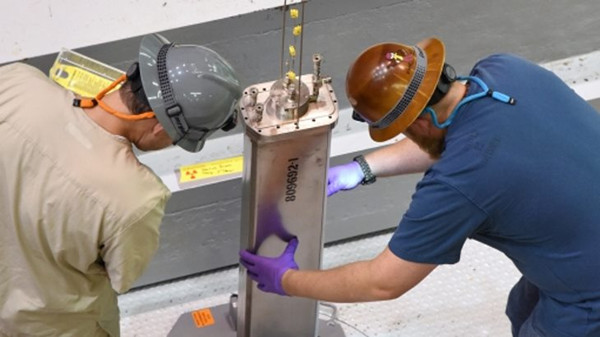Restarted US reactor completes first fuel test
The Transient Reactor Test (TREAT) Facility at the US Department of Energy's Idaho National Laboratory (INL) has completed its first fuelled experiment since resuming operations after a 23-year hiatus.

Workers guide a test capsule into the reactor for its first fuelled experiment in more than two decades. (Image: INL)
"Today at 5:05 pm MDT [the TREAT facility] pulsed for a few seconds, subjecting a small capsule of light water reactor fuel to radiation and heat. The test marked the return of a capability that is critical to the United States' role in the development of nuclear fuels, for both the existing fleet and a new generation of advanced reactors under design," the INL said.
TREAT can produce bursts of energy that are several times more powerful than conditions found in a commercial reactor, allowing fuel performance under extreme conditions - such as a simulated accident situation - to be studied. Exposing fuels to extreme conditions inside such a facility enables more resilient and long-lasting fuels to be developed. Transient testing of nuclear fuels has been likened to high-impact car crash testing, which has helped to advance safety technologies in the automobile industry.
The USA has been without its own transient test reactor since 1994 when TREAT, a simple, self-limiting, air-cooled reactor which produces 100 kWt of steady-state power with a peak transient power of 19 GWt, was placed on standby. The reactor restarted at low power in November 2017.
The first fuel experiment, which was performed on 18 September, is part of a series that will culminate in testing of new fuels being developed for use in light-water reactors by the Department of Energy Office of Nuclear Energy's Accident Tolerant Fuels programme. Data from the experiment will be compared to past tests conducted at TREAT and other historic research facilities to verify modern experiment protocols and demonstrate the performance of instrumentation.
Over the next few weeks further tests will be carried out with fuel samples exposed to increasing energy levels up to the sample's melting point. These studies will lay the foundations for the next ATF experimental campaign which will take place in 2019 and will focus on water-environment testing.
"Restoring this capability in the US keeps our nation in a leading role to develop advanced nuclear fuels and reactor technologies," said INL Laboratory Director Mark Peters said. "Because of that, INL's TREAT facility will once again enable systems that serve the U.S. economy, environment and national security."
- China Institute of Atomic Energy
- Nuclear Power Institute of China
- Southwestern Institute of Physics
- China Nuclear Power Operation Technology Corporation, Ltd.
- China Nuclear Power Engineering Co., Ltd.
- China Institute for Radiation Protection
- Beijing Research Institute of Uranium Geology (BRIUG)
- China Institute of Nuclear Industry Strategy (CINIS)
- China Nuclear Mining Science and Technology Corporation


